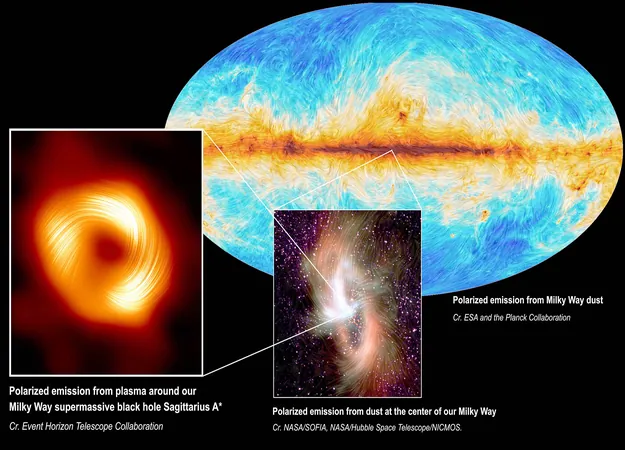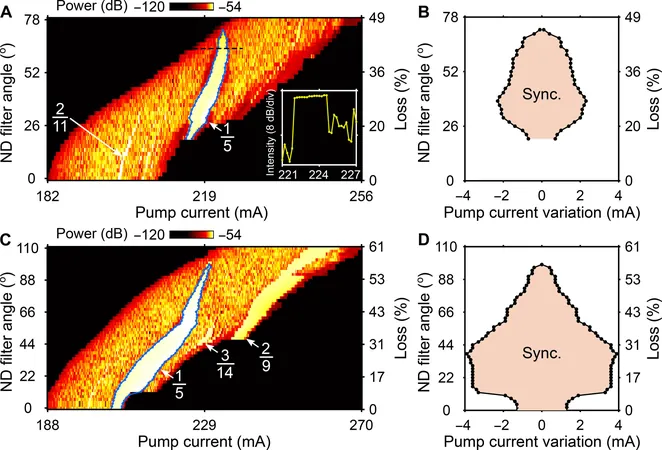
Galactic Discovery: 'Space Tornadoes' Unveiled at the Heart of the Milky Way
2025-03-26
Author: Siti
Unmasking the Galactic Turbulence
The CMZ has long been recognized as a chaotic zone brimming with dynamic flows of matter. However, understanding the driving force behind these turbulent phenomena has remained elusive. In their latest study, scientists led by Kai Yang from Shanghai Jiao Tong University uncovered long, narrow filaments in this turbulent environment—an entirely unexpected find that sheds light on the cyclical nature of material formation and destruction within the CMZ.
Using ALMA’s superior sensitivity, the team identified the filaments by focusing on silicon monoxide (SiO), a molecule that serves as a vital indicator of shock waves. The researchers' meticulous mapping revealed a complex interplay between shock-generated turbulence and these newly identified structures.
The Dynamics of the Galactic Center
The gravitational forces exerted by the supermassive black hole at our galaxy’s center create an environment rife with instability and disturbance. The newly discovered narrow filaments are thought to act as conduits for gas flow, efficiently redistributing materials throughout their surroundings.
"We were astonished by these slim filaments that appeared in the SiO emission lines and were spatially separate from known star-forming regions," shared Yang. The presence of these structures, which do not correlate with dust emissions and seem to lack hydrostatic equilibrium, indicates they have a unique role in the gas dynamics of the region.
The Role of Space Tornadoes in Galactic Chemistry
The research hints that these filaments—potentially likened to "space tornadoes"—could be vital in facilitating the movement of shock-released molecules back into the surrounding environment. According to Xing Lu, a research professor at the Shanghai Astronomical Observatory, "Our findings mark a significant advancement in understanding the material circulation within the Galactic Center landscape."
Interestingly, the filaments appear to be connected to the complex chemistry of the CMZ; the shock waves not only create these structures but also release organic molecules into the interstellar medium. This process suggests that every shock event could contribute to the chemical richness of the region, ultimately impacting star formation or feeding the central black hole itself.
Exploring the Future of Galactic Studies
The presence of these "space tornadoes" could imply that they are more common than initially thought, indicating a broader impact on the CMZ's matter budget. The discovery relies heavily on the detection of specific molecular emissions, particularly the SiO 5-4 rotational transition, which serves as a crucial marker for shock-induced processes in high-density, high-temperature areas of the CMZ.
As researchers look ahead, follow-up studies using ALMA to observe multiple SiO transitions will aim to further validate the origin of these slim filaments and uncover their distribution across the tumultuous central region of the Milky Way. Moreover, simulations will help to intensify the investigation into how these structures contribute to the recycling of matter and play a pivotal role in shaping the environment in which stars and black holes coexist.
This transformative discovery, recently published in the journal Astronomy & Astrophysics, opens new pathways for understanding the complex dynamism at our galaxy's core—shedding light on the intricate dance of matter that fuels the cosmos. Stay tuned as we continue to explore the mysteries of our universe!




 Brasil (PT)
Brasil (PT)
 Canada (EN)
Canada (EN)
 Chile (ES)
Chile (ES)
 Česko (CS)
Česko (CS)
 대한민국 (KO)
대한민국 (KO)
 España (ES)
España (ES)
 France (FR)
France (FR)
 Hong Kong (EN)
Hong Kong (EN)
 Italia (IT)
Italia (IT)
 日本 (JA)
日本 (JA)
 Magyarország (HU)
Magyarország (HU)
 Norge (NO)
Norge (NO)
 Polska (PL)
Polska (PL)
 Schweiz (DE)
Schweiz (DE)
 Singapore (EN)
Singapore (EN)
 Sverige (SV)
Sverige (SV)
 Suomi (FI)
Suomi (FI)
 Türkiye (TR)
Türkiye (TR)
 الإمارات العربية المتحدة (AR)
الإمارات العربية المتحدة (AR)